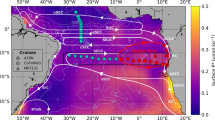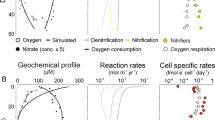Abstract
Fixed nitrogen is one of the main limiting nutrients for primary production in the ocean1,2,3, where it is biologically available in the form of dissolved inorganic and organic matter. Inorganic nitrogen concentrations are consequently very low in surface waters of temperate ocean gyres, yet fixed nitrogen persists in the form of dissolved organic matter. The small, rapidly cycling organic compounds fundamental to microbial and planktonic growth (such as free amino acids, amines and urea4,5) account for only a minor fraction of total dissolved organic nitrogen (DON). In contrast, the vast majority of DON, especially in the deep ocean, resides in the form of nitrogenous substances that are resistant to biological degradation. These substances, which represent an enormous reservoir of fixed nitrogen, are not readily identified by conventional biochemical techniques, but have been assumed to consist largely of structurally complex macromolecules resulting from the degradation and spontaneous abiotic condensation of biochemical precursors6. Here we present 15N NMR measurements that contradict this view. Our results show that most higher-molecular-weight DON in the ocean exists in amide form, rather than as a collection of nitrogen heterocycles that might be indicative of spontaneous condensation products. Because these amides are unlikely to form abiotically, the bulk of the ocean's DON reservoir appears to derive directly from degradation-resistant biomolecules.
This is a preview of subscription content, access via your institution
Access options
Subscribe to this journal
Receive 51 print issues and online access
$199.00 per year
only $3.90 per issue
Buy this article
- Purchase on Springer Link
- Instant access to full article PDF
Prices may be subject to local taxes which are calculated during checkout


Similar content being viewed by others
References
Redfield, A. C., Ketchum, B. H. & Richards, F. A. in The Sea (ed. Hill, N. H.) 26–76 (Wiley Interscience, New York, (1963)).
Smith, S. V., Kimmerer, W. J. & Walsh, T. W. Ventrical flux and biogeochemical turnover regulate nutrient limitation of net organic production in the North Pacific Gyre. Limnol. Oceanogr. 31, 161–167 (1986).
Jackson, G. A. & Williams, P. M. Importance of dissolved organic nitrogen and phosphorus to biological nutrient cycling. Deep Sea Res. 32, 223–235 (1985).
Bronk, D. A. & Glibert, P. M. Nitrogen uptake, dissolved organic nitrogen release, and new production. Science 265, 1843–1852 (1994).
Keil, R. G. & Kirchman, D. L. Contribution of dissolved free amino acids and ammonium to the nitrogen requirements of heterotrophic bacterioplankton. Mar. Ecol. Prog. Ser. 73, 1–10 (1991).
Harvey, G. R., Boran, D. A., Chesal, L. A. & Tokar, J. M. The structure of marine fulvic and humic acids. Mar. Chem. 12, 119–132 (1983).
Benner, R., Pakulski, J. D., McCarthy, M., Hedges, J. I. & Hatcher, P. G. Bulk chemical characteristics of dissolved organic matter in the ocean. Science 255, 1561–1564 (1992).
Benner, R., Biddanda, B., Black, B. & McCarthy, M. Abundance, size distribution, and stable carbon and nitrogen isotope compositions of marine organic matter isolated by tangential-flow ultrafiltration. Mar. Chem. 57, 243–263 (1997).
McCarthy, M. D., Hedges, J. I. & Benner, R. Major biochemical composition of dissolved high-molecular weight organic matter in seawater. Mar. Chem. 55, 281–297 (1996).
McCarthy, M. D., Hedges, J. I. & Benner, R. The chemical composition of dissolved organic matter in seawater. Chem. Geol. 107, 503–507 (1993).
Preston, C. M. Applications of NMR to soil organic matter analysis: history and prospects. Soil Sci. 161, 144–166 (1996).
Knicker, H., Frund, R. & Ludermann, H. D. The chemical nature of nitrogen in native soil organic matter. Naturwissenschaften 80, 219–221 (1993).
Knicker, H., Hatcher, P. G. & Scaroni, A. W. Solid-State 15N NMR spectroscopy of coal. Energy Fuels 9, 999–1102 (1995).
Knicker, H., Hatcher, P. G. & Scaroni, A. W. 13C and 15N-NMR spectroscopic investigation on the formation of fossil algal residues. Org. Geochem. 6/7, 661–669 (1996).
Levey, G. C. & Lichter, R. L. Nitrogen-15 NMR Spectroscopy (Wiley, New York, (1979)).
Cowie, G. L. & Hedges, J. I. Sources and reactivities of amino acids in a coastal marine environment. Limnol. Oceanogr. 37, 703–724 (1992).
Tanoue, E., Nishiyama, S., Kamo, M. & Tsugita, A. Bacterial membranes: possible source of dissolved protein in seawater. Geochim. Cosmochim. Acta 59, 2643–2648 (1995).
Keil, R. G. & Kirchman, D. L. Dissolved combined amino acids in marine waters as determined by a vapor-phase hydrolysis method. Mar. Chem. 33, 243–259 (1991).
van Heemst, J. D. H., Baas, M., de Leeuw, J. W. & Benner, R. in Organic Geochemistry (ed. Oygard, K.) 694–698 (Falch Hurtigtrykk, Oslo, (1993)).
Derenne, S., Largeau, C. & Taulelle, F. Occurrence of non-hydrolysable amides in the macromolecular constituent of Scendesmus quadricauda cell wall as revealed by 15N NMR: Origin of n-alkylnitriles in pyprolysates of ultralaminae-containing kerogens. Geochim. Cosmochim. Acta 57, 851–857 (1992).
De Leuuw, J. W. & Largeau, C. in Organic Geochemistry (eds Engle, M. & Macko, S. A.) 23–72 (Plenum, New York, (1993)).
Rogers, H. J. Peptidoglycans: structure, function and variations. Ann. New York Acad. Sci. 235, 29–51 (1974).
Aluwihare, L., Repeta, D. & Chen R. Amajor biopolymeric component to dissolved organic carbon in seawater. Nature 387, 166–169 (1997).
Bergamaschi, B. A. The Marine Geochemistry of Carbohydrates: Application and Development of New Techniques of Analysis, 1–184 (University of Washington, Seattle, (1995)).
Patience, R. I. et al. The functionality of organic nitrogen in some recent sediments from the Peru upwelling region. Org. Geochem. 18, 161–169 (1992).
Benzing-Purdie, L., Ripmeester, J. A. & Preston, C. Elucidation of Nitrogen forms in melanoidins and humic acid by nitrogen-15 cross polarization magic angle-spinning nuclear magnetic resonance spectroscopy. J. Agric. Food Chem. 31, 913–915 (1983).
Maillard, L. Formation de matieres humiques par action de polypeptides sur les sucres. C. R. Acad. Sci. 156, 148–149 (1912).
Williams, P. M. & Druffel, E. R. M. Radiocarbon in dissolved organic matter in the central North Pacific Ocean. Nature 330, 246–248 (1987).
Knicker, H. & Ludemann, H. N-15 and C-13 CPMAS and solution NMR studies of N-15 enriched plant material during 600 days of microbial degradation. Org. Geochem. 23, 329–341 (1995).
Ripmeester, J. A., Hawkins, R. E., MacPhee, J. A. & Nandi, B. N. On the interaction between pyridine and coal studies by CPMAS 15N NMR. Fuel 65, 740–742 (1986).
Benner, R. & Strom, M. Acritical evaluation of the analytical blank associated with DOC measurements by high-temperature catalytic oxidation. Mar. Chem. 41, 153–160 (1993).
Hedges, J. I. & Stern, J. H. Carbon and nitrogen determinations of carbonate-containing solids. Limnol. Oceanogr. 29, 657–663 (1983).
Acknowledgements
We thank the captain and the crew of the RV John Vickers for assistance with obtaining Equatorial Pacific samples, B. Black for help with sample processing, G. Cowie for advice in amino-acid analysis, and D. Bear for guidance and support.
Author information
Authors and Affiliations
Corresponding author
Rights and permissions
About this article
Cite this article
McCarthy, M., Pratum, T., Hedges, J. et al. Chemical composition of dissolved organic nitrogen in the ocean. Nature 390, 150–154 (1997). https://doi.org/10.1038/36535
Received:
Accepted:
Issue Date:
DOI: https://doi.org/10.1038/36535
This article is cited by
-
NMR spectroscopy of dissolved organic matter: a review
Environmental Chemistry Letters (2023)
-
Dissolved free amino acids and polyamines are two major dissolved organic nitrogen sources for marine bacterioplankton in the northern slope of the South China Sea
Biogeochemistry (2022)
-
Anaerobic bacterial degradation of protein and lipid macromolecules in subarctic marine sediment
The ISME Journal (2021)
-
Responses of plant species diversity and soil physical-chemical-microbial properties to Phragmites australis invasion along a density gradient
Scientific Reports (2017)
-
Deep-ocean dissolved organic matter reactivity along the Mediterranean Sea: does size matter?
Scientific Reports (2017)
Comments
By submitting a comment you agree to abide by our Terms and Community Guidelines. If you find something abusive or that does not comply with our terms or guidelines please flag it as inappropriate.



